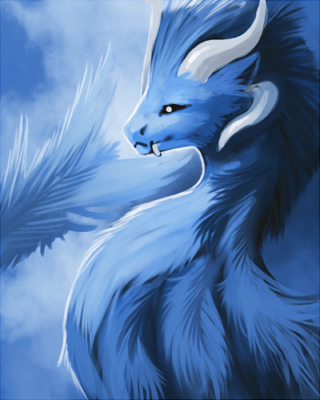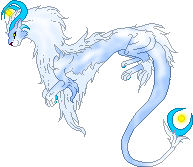The D'jini

General Information;
D'jini, often called 'cloudcats', are a race of intelligent draconic lions said to be one of Scylla's creations alongside the keht'shu as a celebration of peace in Ristell. They are capable of flying without wings, and are said to be light as the air, due to their unique natures. Their coats change color with emotion, and a d'jini's mood can be deciphered easily at a glance.
Statistics;
Name:: D'jini, Cloudcats
Average Lifespan:: 600 years
Average Height:: 5ft/1.5m at the shoulder
Average Weight:: N/A; very light
Location Found:: Ristell; abroad.
*all statistics based on averages; extremes in any direction, or found in odd locations, are always allowed.
Notes;
Fur Color A d'jini's coat color changes with their emotions, and serves as a quick indicator of how any individual d'jini is feeling. Predominantly, their fur color ranges through blues, and other positive tones, in normal circumstances. The saturation of color signifies the intensity of emotion, with brighter, bolder colors revealing stronger feelings, and dull, diluted colors portraying them when they are weaker. Should a d'jini feel a mixture of emotions, colors will dance across their pelt, sometimes in vibrant and moving patterns.
A chart with various fur coloration and their general meanings may be found below.
Positive Emotions:
The colors of positive emotions range from cyans and blues, through purples and pinks, all the way to white.
Pastel Blue: Carefree, Mischievous
Sky Blue: Relaxed, Content, Neutral
Blue: Happy, Optimistic
Royal Blue: Bliss, Goodwill
Lilac: Patience, Kindness
Violet: Lust, Desire
Magenta: Passion, Love, Romance
Pink: Infatuation, Embarrassment
White: Confidence, Exuberance, Courage
Silver: Determination, Calculation, Aloofness
Neutral Emotions:
The colors of neutral emotions range from yellows and greens, through shades of teal.
Gold: Mistrustful, Protective
Yellow: Boredom
Pastel Yellow: Concentration, Contemplation
Pastel Green: Curiosity, Energetic
Green: Inspiration, Creativity
Venomous Green: Ambition
Turquoise: Humility, Sincerity
Teal: Empathetic
Negative Emotions:
The colors of negative emotions range from blacks and browns, through reds and oranges.
Grey: Exhaustion, Tiredness, Drained
Dark Grey: Sick, Ill-feeling
Black: Sorrow, Grief, Depression
Dark Brown: Melancholy, Sadness
Brown: Loneliness, Submission
Tan: Longing, Wistfulness
Maroon: Surprise, Shock
Ruby: Envy, Jealousy
Crimson: Annoyance, Irritation
Blood Red: Rage, Anger, Hatred, Wrath
Red: Powerful, Manic, Aggressive
Red-Orange: Fear, Caution, Hyper-stimulation
Orange: Confusion, Nervousness, Apprehension, Anticipation
Diet This is what this species, and any variants, may eat at any given time.
Common:
traded dishes with keht’shu; prepared meals of meat, dates, fish, fowl, and many other foods.
Uncommon:
large birds and other fowl; various non-sapient flying creatures.
Rare:
unprepared plantlife; land-based animals; carrion.
Overview:
D'jini are varied omnivores, and due to their close ties with the keht’shu, have become enamored of cooked and prepared dishes over their natural diet of flying prey. Most often, prides of d'jini will either trade for meals, or dine with companion keht’shu, some even going so far as to learn how to cook for themselves despite their lack of hands. Prides or individuals that live apart from the keht’shu, or those that prefer a more natural diet, will hunt large birds (such as eagles and other birds of prey) and other non-sapient flying fauna. In times of dire need, d'jini may turn to grazing on tree leaves and tall grasses, with some hunting land-based prey or subsisting on carrion.
The d'jini's only subspecies, the apedemak lion, is very similar to their parent race in that they are moderate omnivores that may partake in a variety of feeding habits. However, they are more prone to hunting than dining with other races, due to their inherent wandering nature.
Credits;
Species info credited to Verridith.
Original concept credited to Kila.
In-Depth Information;
Appearance D'jini are large leonine creatures that have some draconic influences; they are built much like a lion with a very long neck and twisting draconic tail. Their full manes are thick and can be styled in a variety of ways, though they do not often cover the undersides of their throats, which can be protected by scales or plates hidden beneath sleek fur. Some d'jini have manes of feathers instead of fur, and rare cloudcats can be completely covered in them, though none have yet been reported with full and functioning wings.
Sexual dimorphism is a common trait in cloudcats. Males will have full, lush manes that can grow to extravagant lengths and long, often intricate antlers; females have shorter manes that sometimes do not go all the way down their long necks, and only have short horns instead of antlers. Males are often much larger and more muscular, while females are smaller, longer, and thinner. Both do not weigh hardly anything, though males may weight somewhat more than females.
The most unique feature of the d'jini is their colors; while horns, claws, teeth and eyes stay a stable, solid color - with any colors possible - their fur changes color with emotion. Colors and intensities can let onlookers immediately discern the feelings of an individual d'jini, and they are incapable of hiding or changing the color by force. Thus, it's held as a stable fact that when near d'jini, keep an eye on its coat color - at all times. Markings are common on d'jini pelts, though they are never of stable colors, and are only lighter and darker colors that also change with emotion.
Culture D'jini live in small prides either on land or in the sky, led by male and female Kings and Queens. An amicable race, they are all-inclusive, and it is not uncommon to see a pride led by two Kings or two Queens, as well as leaders with multiple established mates. These leaders are always the strongest or wisest in the pride, and often work with a council of elders, which is led by the Teller of Stars, a d'jini Seer. The Teller guides the Kings and Queens on what is best for their pride, and is one of the most well-respected of any d'jini group.
Some d'jini do not live in prides; instead, they live alongside their keht'shu companions, often adorned with jewelry and all manner of trinkets, including paint and dyes to accent their beautiful, color-changing coats. Some act as protectors to the keht'shu, and others bond as dragons and riders do, while few become leaders among their cloud-walking friends.
Abilities Crafters of the clouds and travelers of the sky, d'jini can fly like eastern dragons without wings, and can run and stand on clouds that would not otherwise hold a traditional creature. They are very, very light, almost weightless, and can float and fly among the clouds with ease. Though d'jini may have any ability, all have the power to create and build out of clouds, fog, and mist; they can enchant and solidify clouds into solid structures, as well as separate the moisture from the air to create very small, brief, and localized rainstorms. Bits of cloud often clings to them as they pass, and 'shedding the clouds' has become a Ristellan saying for coming down from a joyous moment, such as a d'jini does when returning to the earth from the sky.
Species Origin;

None can be sure if it was shortly before or shortly after, but Scylla created the d’jini around the same time she created the first keht’shu.The d’jini, or cloudcat, was to be a friend and companion to the keht’shu, for they would live in the skies, flying from cloud to cloud as they pleased.
To that end, Scylla gathered clouds of all kinds, from the small wispy clouds that drifted high in the sky, to low-lying clouds heavy with rain, puffy white clouds that reflected the sun, and angry, dark storm clouds. She combined them together, and formed them into a shape reminiscent of that of a great lion, though parts of it resembled the form of a dragon. To this, the first d’jini, she gave a thick mane and a long tail, and a thick coat that would change colors with his emotions.
She introduced her new creations to one another, and smiled as they set out to explore their new domain. Over time, she created more cloudcats, until several prides of d’jini lived and hunted among the clouds, often living side by side with clans of keht’shu. Much like the keht’shu, most d’jini have remained on Ristell, though some have migrated to other Realms.
It is also very common to find keht’shu off of Ristell to be accompanied by a cloudcat, particularly in areas where avians might live. With a d’jini on watch, few avians tend to risk its wrath to try to destroy its keht’shu companion’s wings, for a cloudcat, when roused to anger, can become as destructive as a thunderstorm.
This Ancient First was a d’jini whose emotional colors almost always ranged in the greens and blues of positive emotion. Sweet and kind, she was something of a loner, preferring the open sky to the company of others, though she treated them with compassion whenever possible. She had will over water, and often brought rain to drought-ridden lands.
subspecies

Apedemak Lions
Classification: Scylla-blessed, good-weather d'jini. Location: abroad, but rare.
Known to be counterparts to the keravnos, apedemak lions are sun-shepherds; rare, blessed d'jini that herald sunlight and good weather wherever they go. Much like d'jini are called cloudcats, many apedemas are referred to as 'sunlions', though they have no relation to actual lions at all. Storms flee in their presence, and clear skies follow them wherever they fly, during any time of the day or night.
Most apedemas do not speak out loud, but use telepathy, allowing their mind's voice to resonate where their physical voice may not. They are seen as a good omen, and are praised for the weather they bring, especially in areas where rain or snow is very common. However, they never stay in one place long, and constantly travel, lest they bring drought to a verdant area.
Unlike normal d'jini, apedemas do not have the fur that changes with their emotions; instead, this has been noted in their eyes, which shift in hue like their cousins' coats do. Their pelts are instead painted the color of the sky that they were hatched under, from dawn purples and pinks and clear blue with faint wisps of cloud, to midnight blues and blacks speckles in glowing stars. Markings are light in color on dayborn apedemas, and dark in color on nightborn - though a reversal has been noted on very rare occasions. Most apedemak lions are hatched from a single-egg nest, and the parents do not often breed.
Apedemak lions have bright, curving horns crowning their heads and tipping their tails, in any color and often crystalline in appearance. These curling horns grow around small orbs that glow and dim in response to the time of day, shifting color according to whatever moons or suns they are under at any given time. Softer of fur and with long, silky manes, apedemas are beautiful creatures and generally keep themselves very well groomed.
Due to their rarity, apedemak lions are a limited store species; please do not make one unless bought. Thank you!
